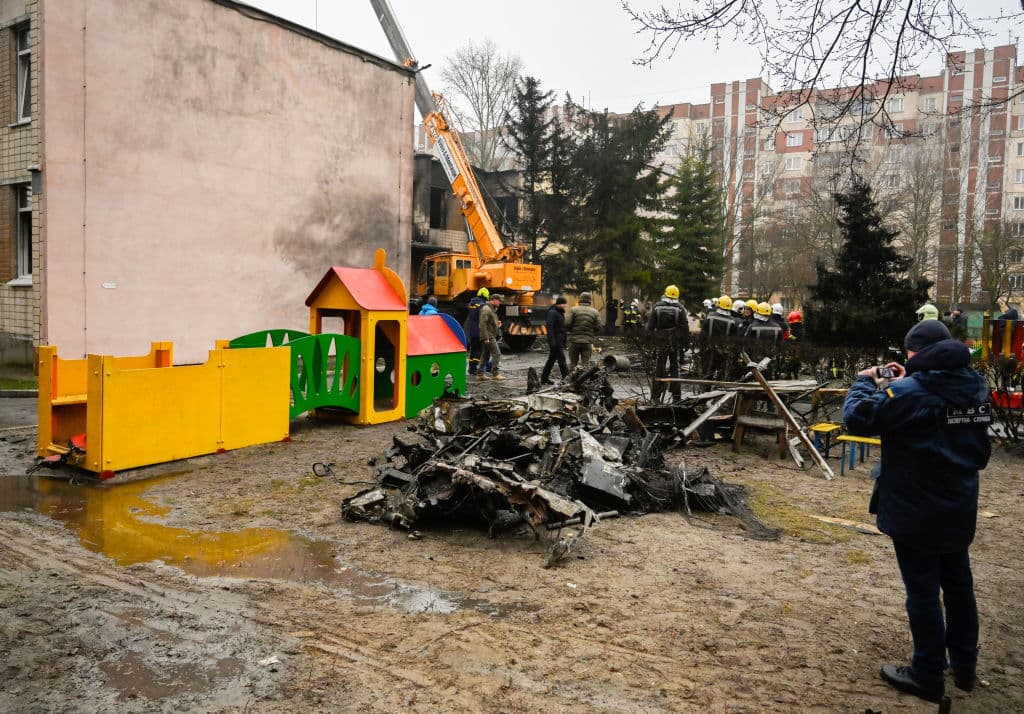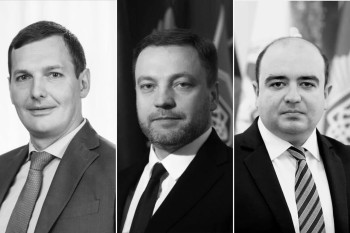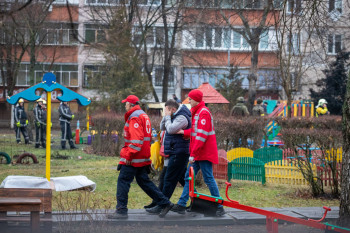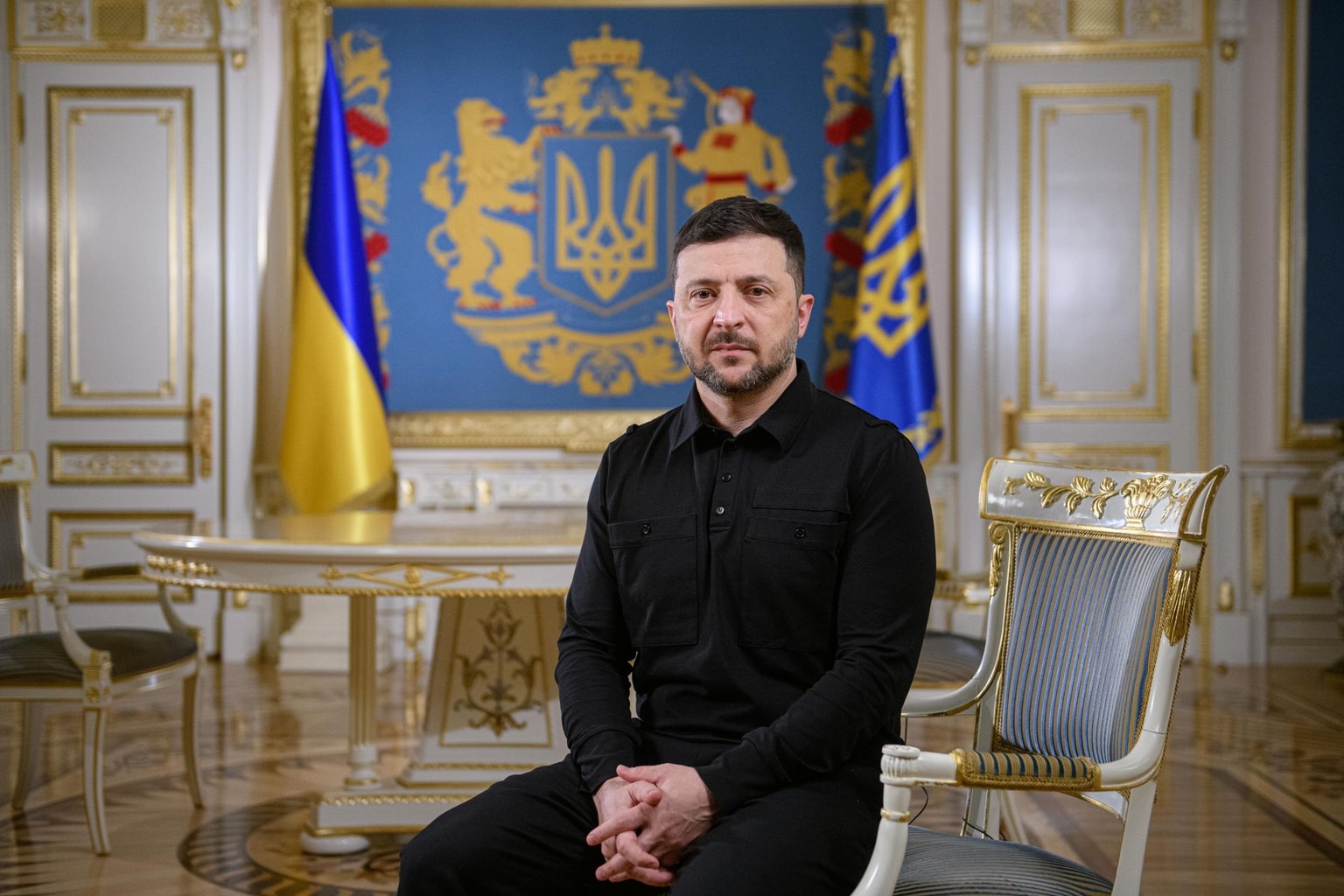Explainer: What we know about helicopter crash that killed children, top officials

In the morning on Jan. 18, a helicopter carrying Ukraine's Interior Ministry top officials crashed next to a kindergarten and an apartment building in Brovary, a city just east of Kyiv, claiming the lives of 14 people, including all 10 people onboard.
Interior Minister Denys Monastyrsky was the most senior Ukrainian official killed since the start of Russia’s full-scale invasion on Feb. 24. His first deputy also died in the crash.
"It is a truly great loss for the state," President Volodymyr Zelensky said in his regular evening address.
According to Zelensky, "all the necessary decisions were made" regarding the ministry's management. However, the people killed in Brovary "are not those who can be easily replaced," Zelensky said. National Police Head Ihor Klymenko was appointed as the acting interior minister.
The Security Service launched an investigation into the incident.
Here is what we know about the incident so far.
Who were the victims?
At least 14 people were killed, including all 10 people onboard and four more on the ground.
The 10 people aboard included seven Interior Ministry employees:
- Denys Monastyrsky, interior minister
- Yevhen Yenin, first deputy interior minister
- Yuriy Lubkovych, the ministry's state secretary
- colonel Mykhailo Pavlushko, Monastyrsky’s security chief
- Andriy Marynchenko, senior police officer
- Tetiana Shutiak, an employee of the ministry’s patronage service department
- Mykola Anatsky, an employee of the ministry’s communications department
The other three were crew members: helicopter crew commander Oleksandr Vasylenko, pilot Kostiantyn Kovalenko, and mechanic Ivan Kasianov.
Five civilians, including one child, were reportedly killed on the ground as the helicopter crashed near a kindergarten.
Where were the officials heading on the helicopter?
According to Kyrylo Tymoshenko, deputy head of the President's Office, the Interior Ministry officials were en route to a "hot spot" of Russia’s war.
Kharkiv Oblast Police Chief Volodymyr Tymoshko said the helicopter was headed to this northeastern region.
Later, Ukrainska Pravda news outlet reported, citing unnamed sources, that the officials were heading to Bakhmut, a town in eastern Donetsk Oblast which has been the site of the fiercest fighting in the past months.
The helicopter was supposed to land to refuel in central Poltava Oblast before finally reaching Kharkiv Oblast. From there, the group was supposed to travel by car about 200 kilometers southeast, to Bakhmut.
Is it even possible to travel by helicopter in Ukraine now, during wartime?
According to aviation expert Bohdan Dolintse, the use of helicopters by top officials during wartime is a "completely justified step,” if such transport is not used within the range of the enemy's air defense systems.
Dolintse told the Kyiv Independent that the risk of using aircraft is relatively low at a distance of up to 100-120 kilometers from the front line or the area where Russian air defense systems are located, which is the range at which they can effectively identify and destroy targets.
"When flying in the rear, there is still a risk of missile strikes. However, it is relatively low as aircraft can adjust their route after being notified of a threat, or apply other special action protocols," the expert explained.
"As ballistic or cruise missiles are programmed with coordinates before their launch, they can effectively target mainly only static (not moving) objects," Dolintse said.
Also, to reduce the risk of being targeted by surface-to-air missiles, helicopters usually fly low, at levels undetectable by radars, according to BBC weapons expert Chris Partridge.
"Flying low also reduces the risk of the aircraft being attacked by other anti-aircraft systems, such as smaller shoulder-launched infrared weapons, when the aircraft enters a contested battlefield," he told BBC.
Flying at low level, however, increases the risk of hitting the ground, Partridge added.
"This type of flight is intensive and quite stressful for pilots, especially in an urban environment with many structures such as buildings and trees," he explained.
Isn't there a safety rule that top officials don't travel in the same vehicle?
It is generally not forbidden by Ukrainian law to transport several top officials in the same vehicle.
However, experts say that during wartime, governmental agencies were likely recommended not to concentrate several top officials in one vehicle if possible.
"But we have to understand that different circumstances and factors could influence the decision," aviation expert Bohdan Dolintse told the Kyiv Independent.
"There could be simply only one aircraft available at the moment, or some risk factors existing that we are not aware of," he said.
What do we know about the helicopter?
The Airbus H225 Super Puma helicopter that was carrying Interior Ministry officials belonged to the State Emergency Service, the agency said.
"The helicopter with board number 54 was repeatedly involved in carrying out tasks of transporting personnel to places of emergency situations," the statement reads.
The agency stated that the aircraft's crew was prepared to perform tasks under difficult conditions and had the required number of flight hours precisely on Airbus H225 Super Puma vehicles to operate them.
"Among aircraft used by the Interior Ministry, this aircraft was most often used due to its ability to transport a sufficient number of people at the same time," the State Emergency Service added.
Yurii Ihnat, the spokesperson of Ukraine’s Air Force, said that this type of helicopter was specifically used by the Interior Ministry and the State Emergency Service, and they were engaged in "various special tasks," including "those close to the areas of hostilities."
The Airbus H225 Super Puma helicopters were supplied to Ukraine by France as part of a 555 million euro contract signed by then-Interior Minister Arsen Avakov in 2018. The contract details were published by ProZorro, Ukraine's electronic public procurement system, designed to increase transparency and competition in the bidding process.
Over the next three years, Ukraine received 55 Super Puma helicopters, 21 of which were the H225 model. This was part of a program to modernize Ukraine's aircraft fleet, which had previously mainly consisted of old Soviet vehicles.
These helicopters were handed over to the State Emergency Service, the State Border Guard Service, the police, and the National Guard. The State Emergency Service used them to extinguish large-scale fires and in other emergency situations.
Nearly a half of the helicopters were not brand new – they had a wear rate of 50% of some of the parts, were overhauled and modernized for Ukraine to use.
Helicopters of this type are used by a number of Western countries such as France and Spain.
What could have caused the crash?
The Security Service of Ukraine, or SBU, opened an investigation that is currently considering several versions of what had caused the crash, including: violation of flight security rules, technical malfunction of the helicopter, and intentional actions to destroy the vehicle.
At the same time, the air force spokesperson, Yurii Ihnat, said that the crash will be investigated by the special state commission that is yet to be created, and the process would take "not a couple of days," but at least several weeks.
"Usually, a plane (or helicopter) crash investigations require a significant amount of time. This is a common practice not only in Ukraine but around the globe," Ihnat said.
"Every detail of the aircraft is collected and analyzed as it can provide important information about the incident."
Ihnat also noted that the weather conditions on Jan. 18 "were not optimal."
On that day, the weather in Brovary was foggy and windy.
While the Ukrainian authorities agree it is too early to say what exactly caused the fatal incident in Brovary, Zelensky said that, regardless of the reasons, "it wasn't just an accident."
"I believe, given my experience with war and the current state of our society, that this was not an accident – it was the war," he said in a video address to the World Economic Forum in Davos on Jan. 18.
"War is not limited to the battlefield – it has many fronts. There are no mere accidents. Everything that happens is the result of war."
Is foul play suspected?
Zelensky called on the Security Service chief to establish the circumstances of the crash and assured that the authorities would provide information on what led to the crash as soon as possible.
The Prosecutor General's Office said "all possible versions" of the helicopter crash are on the table.
"The investigation will answer all the questions. It will take time," Acting Interior Minister Ihor Klymenko said on Jan. 18.
Didn’t the number of victims change several times?
Information provided by rescuers, police, and local authorities varied throughout the day on Jan. 18.
The most recent update, on Jan. 18 afternoon, suggested 14, including one child, had been killed after previous reports that the number of the killed children was at least four.
Just after the crash, National Police Chief Ihor Klymenko said that 16 people were killed, including two children. National Police spokesperson Mariana Reva said on national television, 16 were killed, including three children.
Kyiv Oblast Governor Oleksii Kuleba said on Jan. 18 that 18 people were killed, including three children.
Two hours later, the Emergency Service reported 17 were killed, including four children.
Finally, the Emergency Service updated the casualty information to 14 killed, including one child, and 25 injured, including 11 children. The agency said that the information was changing as the process of “identifying body fragments” was ongoing.
All injured have been hospitalized, the Emergency Service said on Jan. 18.
Who is Ihor Klymenko, new acting interior minister?
Until Jan. 18, there were no discussions on who could be the potential successor of Monastyrsky. The late interior minister replaced his controversial predecessor Arsen Avakov in July 2021. Avakov spent seven years at the post.
Monastyrsky had five deputies aside from late deputy Yenin who could take over the post, but the government selected National Police Chief Ihor Klymenko to serve as the acting interior minister.
"After discussions with the parliament, we will submit a proposal for the appointment of a new (permanent) minister," Prime Minister Denys Shmyhal said on Jan. 18.
Police General Klymenko, 50, has served as the head of the National Police since September 2019. Now, as an acting minister, Klymenko will oversee policing, security, and emergency services in Ukraine.
Born in Kyiv, Klymenko graduated from the Kharkiv Military University in 1994. He served in Ukraine's Armed Forces for three years in the mid-1990s.
Since 1998, Klymenko has served in different positions in the Interior Ministry, including one deployment as a peacekeeper in Kosovo in 2002.
He has also served as a psychologist and got his Doctor of Psychology degree in 2019.
In October 2017, Klymenko was appointed as Deputy National Police Chief to oversee the human resources department.
During the full-scale Russian invasion, Klymenko provided frequent updates on the attacks and atrocities by the Russian forces.
"This tragedy should show us that the war is ongoing," Klymenko said on Jan. 18 as acting interior minister.














